
Wallace Fitzgerald Beery was an American film and stage actor. He is best known for his portrayal of Bill in Min and Bill (1930) opposite Marie Dressler, as General Director Preysing in Grand Hotel (1932), as Long John Silver in Treasure Island (1934), as Pancho Villa in Viva Villa! (1934), and his titular role in The Champ (1931), for which he won the Academy Award for Best Actor. Beery appeared in some 250 films during a 36-year career. His contract with Metro-Goldwyn-Mayer stipulated in 1932 that he would be paid $1 more than any other contract player at the studio. This made Beery the highest-paid film actor in the world during the early 1930s. He was the brother of actor Noah Beery and uncle of actor Noah Beery Jr.
The following is an overview of 1931 in film, including significant events, a list of films released and notable births and deaths.

Min and Bill is a 1930 American Pre-Code comedy-drama film, directed by George W. Hill and starring Marie Dressler and Wallace Beery. Adapted by Frances Marion and Marion Jackson from Lorna Moon's 1929 novel, Dark Star, the film tells the story of dockside innkeeper Min's tribulations as she tries to protect the innocence of her adopted daughter, Nancy, while loving and fighting with boozy fisherman Bill, who resides at the inn. The picture was a runaway hit. In 1931, the studio released a Spanish-language version of Min and Bill, La fruta amarga, directed by Arthur Gregor and starring Virginia Fábregas and Juan de Landa.

Jean Harlow was an American actress. Known for her portrayal of "bad girl" characters, she was the leading sex symbol of the early 1930s and one of the defining figures of the pre-Code era of American cinema. Often nicknamed the "Blonde Bombshell" and the "Platinum Blonde", Harlow was popular for her "Laughing Vamp" screen persona. Harlow was in the film industry for only nine years, but she became one of Hollywood's biggest movie stars, whose image in the public eye has endured. In 1999, the American Film Institute ranked Harlow No. 22 on their greatest female screen legends of classical Hollywood cinema list.

John Brown was an American college football player and film actor billed as John Mack Brown at the height of his screen career. He acted and starred mainly in Western films.

Hell Divers is a 1932 American pre-Code black-and-white film from Metro-Goldwyn-Mayer starring Wallace Beery and Clark Gable as a pair of competing chief petty officers in early naval aviation. The film, made with the cooperation of the United States Navy, features considerable footage of flight operations aboard the Navy's second aircraft carrier, the USS Saratoga, including dramatic shots of takeoffs and landings filmed from the Curtiss F8C-4 Helldiver dive bombers after which the movie was named.
That's Entertainment! is a 1974 American compilation film released by Metro-Goldwyn-Mayer to celebrate the studio's 50th anniversary. The success of the retrospective prompted a 1976 sequel, the related 1985 film That's Dancing!, and a third installment in 1994.

Marjorie Burnet Rambeau was an American film and stage actress. She began her stage career at age 12, and appeared in several silent films before debuting in her first sound film, Her Man (1930). She was twice nominated for the Academy Award for Best Supporting Actress for her roles in Primrose Path (1940) and Torch Song (1953), and received the 1955 National Board of Review Award for Best Supporting Actress for her roles in A Man Called Peter and The View from Pompey's Head.
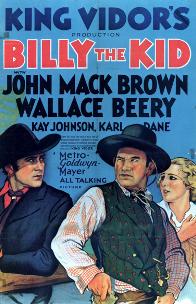
Billy the Kid is a 1930 American pre-Code Western film directed in widescreen by King Vidor about the relationship between frontier outlaw Billy the Kid and lawman Pat Garrett. In February 2020, the film was shown at the 70th Berlin International Film Festival, as part of a retrospective dedicated to King Vidor's career.

Tugboat Annie is a 1933 American pre-Code film directed by Mervyn LeRoy, written by Norman Reilly Raine and Zelda Sears, and starring Marie Dressler and Wallace Beery as a comically quarrelsome middle-aged couple who operate a tugboat. Dressler and Beery were MGM's most popular screen team at that time, having recently made the bittersweet Min and Bill (1930) together, for which Dressler won the Academy Award for Best Actress.
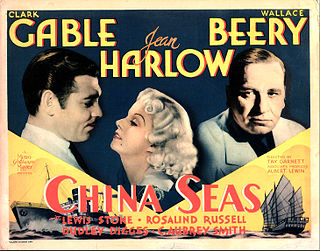
China Seas is a 1935 American adventure film starring Clark Gable as a brave sea captain, Jean Harlow as his brassy paramour, and Wallace Beery as a suspect character. The oceangoing epic also features Lewis Stone, Rosalind Russell, Akim Tamiroff, and Hattie McDaniel, while humorist Robert Benchley memorably portrays a character reeling drunk from one end of the film to the other.
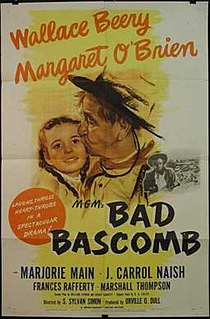
Bad Bascomb is a 1946 American western film starring Wallace Beery and Margaret O'Brien. The movie was directed by S. Sylvan Simon. The supporting cast features Marjorie Main, J. Carrol Naish, Frances Rafferty, Marshall Thompson and Henry O'Neill.
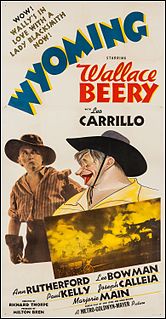
Wyoming is a 1940 Western film directed by Richard Thorpe and starring Wallace Beery. It was the first of seven films pairing Beery and character actress Marjorie Main.

Jackass Mail is a 1942 Western comedy film directed by Norman Z. McLeod and starring Wallace Beery and Marjorie Main.

Big Jack is a 1949 American Western film starring Wallace Beery, Richard Conte and Marjorie Main. The movie was directed by Richard Thorpe, and the screenplay was written by Gene Fowler and Otto Eis from the novel by Robert Thoeren. The picture is a comedy-drama, set on the American frontier in the early 1800s, about outlaws who befriend a young doctor in legal trouble for acquiring corpses for anatomical research.
Laughing Sinners is a 1931 American pre-Code Metro-Goldwyn-Mayer feature film starring Joan Crawford and Clark Gable in a story about a cafe entertainer who experiences spiritual redemption. The dialogue by Martin Flavin was based upon the play Torch Song by Kenyon Nicholson. The film was directed by Harry Beaumont. Laughing Sinners was the second of eight cinematic collaborations between Crawford and Gable.

Saratoga is a 1937 American romantic comedy film written by Anita Loos and directed by Jack Conway. The film stars Clark Gable and Jean Harlow in their sixth and final film collaboration and features Lionel Barrymore, Frank Morgan, Walter Pidgeon, Hattie McDaniel and Margaret Hamilton.
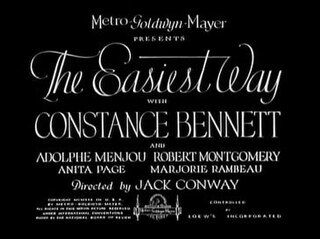
The Easiest Way is a 1931 American pre-Code MGM drama film directed by Jack Conway. Adapted from the 1909 play of the same name written by Eugene Walter and directed by David Belasco, the film stars Constance Bennett, Adolphe Menjou, Robert Montgomery, Marjorie Rambeau, Anita Page, and Clark Gable

Hold Your Man is a 1933 American pre-Code romantic drama film directed by an uncredited Sam Wood and starring Jean Harlow and Clark Gable, the third of their six films together. The screenplay by Anita Loos and Howard Emmett Rogers was based on a story by Loos.
Strictly Personal is a 1933 American pre-Code drama film directed by Ralph Murphy, written by Beatrice Banyard, Willard Mack, Wilson Mizner, Casey Robinson and Robert T. Shannon, and starring Marjorie Rambeau, Dorothy Jordan, Eddie Quillan, Edward Ellis, Louis Calhern, Dorothy Burgess and Rollo Lloyd. It was released on March 17, 1933, by Paramount Pictures.

















